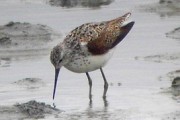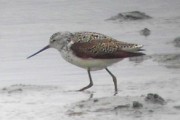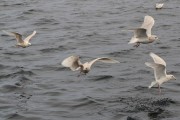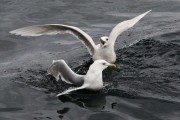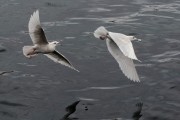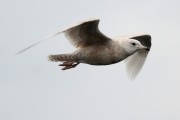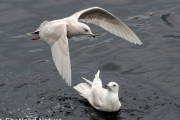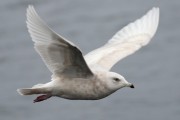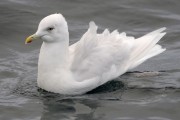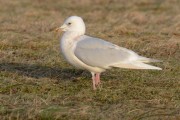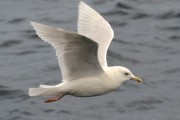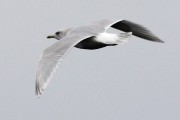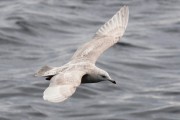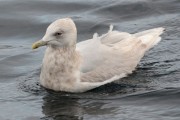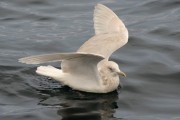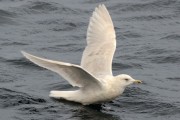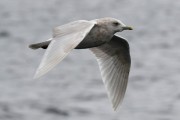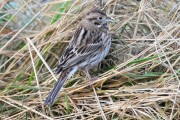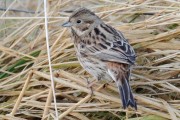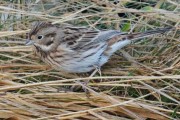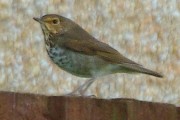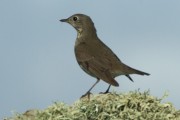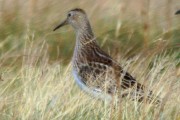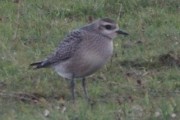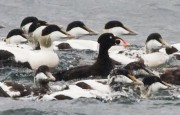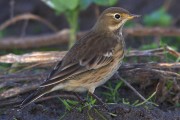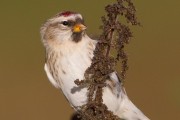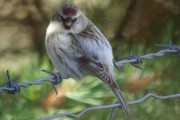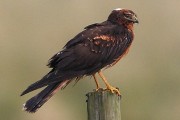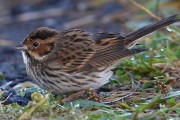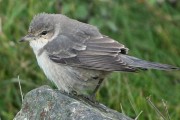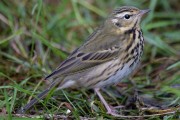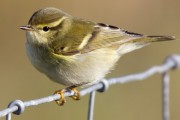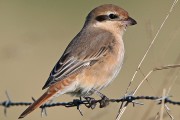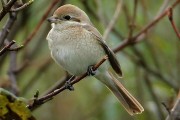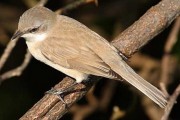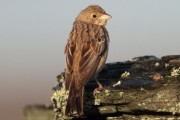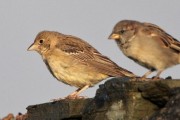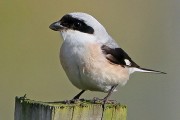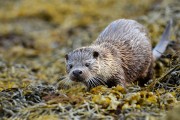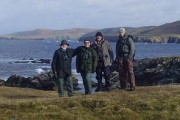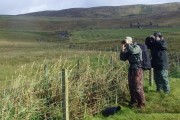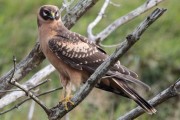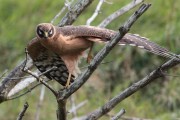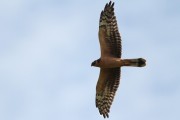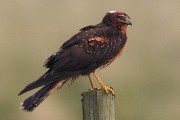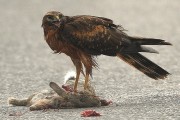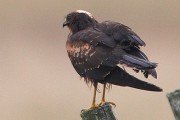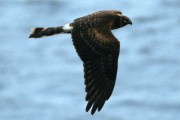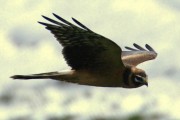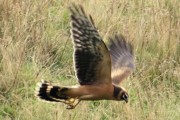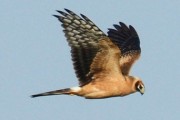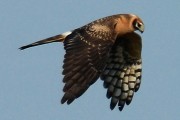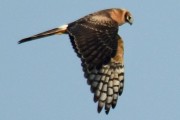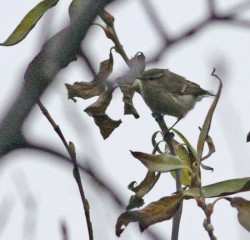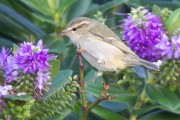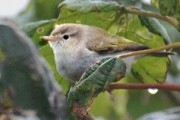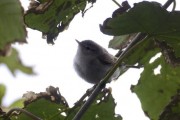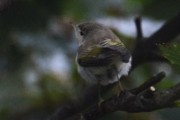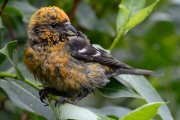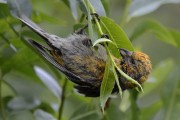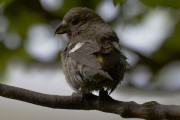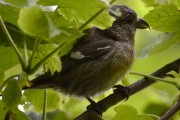Archive for the ‘Birding in Shetland’ Category:
Marsh Sandpiper at Virkie – The Second Shetland Record
Posted by Rob Fray on Saturday 14th July 2012 | Birding in Shetland
Finding rare birds is sometimes the result of hard work, skill and determination. On other occasions, it can be down to luck. The latter was the case with Shetland’s second ever Marsh Sandpiper…
My brother Richard had arrived from Arizona in early July, bringing with him a group from Borderland Tours, and I had agreed to help out with guiding them for their trip to Shetland (don’t tell Brydon about this bit of ‘moonlighting’). Our plan for Saturday 7th July was to sail round Noss on the ‘Dunter’ to look at the gannetry, but the rather unseasonal weather (a north-easterly gale) scuppered that idea, with the pre-booked ferry trips being cancelled the previous night. Richard and I discussed what we could do instead. I had noticed a few waders outside my house on the Pool of Virkie early in the morning, including Knot and Bar-tailed Godwit (which, as the majority of the guests on the trip were from America, was of interest to them); that was our new plan for the morning sorted.
By about 09:30 we were all in situ, in the turning circle in front of my house, scanning the pool. A Knot and a couple of Bar-tailed Godwits were visible distantly at the east end of the pool, near the Ness Boating Club, so being ‘lead driver’ I took the first minibus up the road for a closer look. The short journey was rudely interrupted when a small group of Redshanks took to flight, accompanied by a smaller wader which, to the naked eye, appeared to have a white rump. This was clearly going to be something ‘different’. Minibus brought to an abrupt halt, I quickly scanned through the Redshanks, which had landed a little distance away. Imagine my surprise, as the saying goes, when I clapped eyes on what looked for all the world like a summer-plumaged Marsh Sandpiper! I couldn’t remember whether this was a first or a second for Shetland, but whichever it was, it was mightily important.
The next five or ten minutes were a combination of chaos and comedy. I leapt out of the minibus to get my ‘scope out of the boot, whilst trying to use a walky-talky to alert Richard in the other minibus about what I’d just seen. A few garbled messages later and I think he got the general gist of what I was trying to say. The leg fell off my tripod whilst I was trying to scope the bird, at which time I swore (politely) a lot and the guests in my minibus all started looking at me with a mixture of amusement and pity (whilst not really knowing what on earth was actually going on). The Marsh Sand flew, and I couldn’t see it any more. One of Richard’s group then refound it, and Richard got a look at it too, only for a low-flying helicopter to flush all the waders on the pool in all directions. I was getting more stressed and more incoherent by the minute, but thankfully the bird reappeared again, much closer and appearing a little more settled. Anybody with a camera was ordered to take a photo of the small boring grey wader in front of us, and ignore the nice brightly-coloured godwits and Knot for the time being. I was now a bit calmer, and managed to text out the news without any more mishaps.
The bird continued to be very flighty, and behaved as though it had only just arrived in Shetland. Marsh Sandpipers are not usually associated with tidal habitats such as the Pool of Virkie, being more of a freshwater species, so maybe its erratic behaviour reflected this. It only remained at Virkie for a few hours, before flying off over Toab and being relocated later in the day at the more suitable site of Loch of Hillwell. It was not seen on subsequent days.
This is only the second Marsh Sandpiper to be seen in Shetland; the first was way back in 1969, at Strand, so was a Shetland tick for almost everybody. There have been just eight previous Marsh Sandpipers recorded in Scotland, the last of these being in Highland in October 2000.
As mentioned in the opening lines of this write-up, luck can play a huge part in finding rare birds. Had it not been for a couple of cancelled boat trips, we would have been happily sailing round Noss and nowhere near the Pool of Virkie. For once, the sometimes nasty summer weather in Shetland was a bonus.
Finally, thanks to all on the Borderland Tours trip, who put up with their guide having a total meltdown in front of them! I think everybody enjoyed themselves.
Rob Fray
Permalink
Iceland Gull influx in Shetland 2012
Posted by Brydon Thomason on Saturday 21st January 2012 | Birding in Shetland
Arrivals of ‘white-winged’ gulls, namely Iceland and Glaucous, are all but guaranteed in the isles during a Shetland winter. Year on year numbers may however vary considerably, with some years
occasionally recording numbers, of Icelands particularly, reaching up into the early teens on any given day around Lerwick’s harbours. Glaucous gulls too may also on a ‘good year’ be seen in similar numbers but tend to be a little scarcer.
This winter an unprecedented influx of Iceland gulls has undoubtedly taken centre stage amongst the islands ornithologists and has certainly caught the attention of keen-eyed islanders Shetland
wide. Presumably the storm force winds from the north-west straight down from Greenland during the last week of 2011 were responsible for sparking the influx. By the end of the first week of
January numbers of Iceland gulls were clearly rising towards record numbers, which continued to increase as birds which were presumably moving south-east across the North Atlantic drifted in.
This movement was evident elsewhere too with the Faroe Islands also recording exceptionally high numbers and a pattern of their numbers peaking a few days ahead of ours was illustrated by respective arrivals. Throughout many parts of the UK and Ireland the influx continued and was still very much underway at the time of writing.
In conscious bid to record and document such an exceptional event, co-developer (and SN team member) of the Nature-in-Shetland website Rob Fray and others co-ordinated a Shetland wide search for Iceland Gulls. Over 20 observers took part offering quite an extensive coverage of the county which produced a team effort of over 150 birds. Read more about the count and the influx on the Nature in Shetland blog and also joining Nature in Shetland on Facebook is highly recommended as you can receive and follow bird news as well as whale and dolphin sightings as they happen; http://www.facebook.com/natureinshetland
What was quite apparent and unusual right from the first few Iceland’s to arrive was that there were very few first winter (fledged the summer of the same year) birds. Instead the large majority were in fact second winter birds, while numbers of third winter and adult birds were way higher than normal arrivals. But where do all these ‘sub-adults’ usually go and why has this year seen so many arrive? Even in previous ‘big’ years for Iceland gulls adult and sub-adult birds tend to be well in the minority. Perhaps this picture will become clearer in due course or indeed as the influx continues. It may well be simply that they have suffered a very poor breeding season and that the hurricane force winds hailed directly from regions where winter numbers peak, imagine the numbers if first winter birds were statistically similar to previous arrivals!
Amongst these, many individuals showing features of ‘Kumliens type’ Iceland gulls can be identified by keener eyed observers. ‘Kumliens type’ are basically birds that derive from populations in the
Canadian Arctic where Thayer’s gull and Iceland gull’s interbreed, some even class it as a subspecies.
Within those ranges and indeed beyond into neighbouring ones the genes are effectively diluted and many birds may have either or both genes and many without showing any plumage detail to even
speculate as to identification.
These images show variations of individuals showing characteristics of ‘Kumlien’s’. Basically birds showing varying shades of grey along the outer webs of the outermost primaries (cf pure white on
Iceland Gull) which reach and usually hook back inward on the tips would be a good candidate. One well marked contender’s the pattern on the wing tips, with the small white droplets can be quite
distinct as it reduces inward across a few primary feathers. Most Kumien’s also tend to be slightly larger and heavier billed, perhaps not so cute in proportions as Iceland’s and younger birds tend
to show darker and dirtier tones in plumage, especially in their tail and wing covers. But oh what excitement a Thayer’s would bring us…
Permalink
Pine Bunting – Clibberswick, Unst, Shetland
Posted by Brydon Thomason on Friday 23rd December 2011 | Birding in Shetland
In birding and especially for a rarity hunter, there are months (and obviously locations) that offer much more potential than others. Indeed there are also months where the target species are reduced to a mere handful, which in turn are all the more desirable. In Shetland, November is one such a month and Pine Bunting such a species. It was with this in mind and following several days of south easterlies myself and Mike Pennington targeted what remained of the harvested crop fields round north Unst on Saturday 5th November (as well as sandy beaches for Desert wheatear!).
The morning’s birding had produced little more than a couple of ‘sibe’ type Chiffchaffs, Woodcock, a couple of Northern Wheatears and a female type Yellowhammer. But that’s November, we were not perturbed by this, thoughts of Pine Bunting and Desert Wheatear kept the optimism up. This very same spirit has served us well in previous Novembers with finds such as Hume’s and an unseasonal Arctic Warbler amongst other rarities.
We arrived at Clibberswick in the early afternoon and began to walk the recently harvested ‘crop field’, where a fairly narrow strip of stubble and empty potato patch were all that remained. From the crop a Jackdaw, two Twite and a single Brambling appeared to be our lot but, nearing the end of the small crop, half a dozen Skylarks took to the wing and were joined by the Brambling. As they all broke the skyline, however, another passerine had joined them, a bunting. It took us just a second or two to train focus on the bunting, now giving a distinct Yellowhammer like ‘tsik’ as it descended towards a fence where it landed facing us about 30 yards away.
We found ourselves looking at a distinctly grey and white bunting, with a very white belly and submoustachial stripe, pale whitish supercilium, gorget of fine thin grey streaks, which appeared to show just a hint of a faint ‘reddish’ hue (which in some lights could not be seen), across the breast and no yellow in the plumage. It was obviously very different to the corresponding female/immature plumage of the Yellowhammer we had seen earlier. “It’s a Pine Bunting” was immediately and rather excitedly blurted out (along with a word best left unpublished!). The bunting dropped from the fence down onto the bare soil of the potato crop briefly before flying further towards the far end of the crop.
Exhilarated and rather stunned by what we had just seen and said and following a moment to at least try to gain composure, we agreed that photographs should probably be conclusive documentation, especially as this was clearly a female. We ran to the car for our cameras! Yes, one of us should have stayed with it but common sense is rarely a commodity in such adrenalin-fuelled occasions!
Luckily, minutes later, on our breathless return, we found the bird where we had last seen it. Our initial first impressions and observations all checked out. We also confirmed the absence of any yellow fringing in the primaries; instead they were thinly and frostily fringed with white, as our photographs also confirmed. To further dispel any doubt or worries about potential hybridisation (a well-known pit fall), chance images of the underwing showed the axillaries and underwing coverts to be totally white, lacking any suggestion of Yellow. And although totally confident in our identification (and without having any literature to hand), I made a quick call to Roger Riddington for a second opinion/confirmation on our thoughts of PB’s call being synonymous with that of Yellowhammer.
She was the real deal and all things assessed in front of us surely as pure Pine as you could hope for!
Permalink
Shetland Autumn Birding 2011
Posted by Martin Garner on Monday 19th December 2011 | Birding in Shetland
A round up of our highlights from this year’s two week-long Autumn Birding holidays.
Arrivals from all points of the Compass
What would this year bring? The question buzzed around my mind in the days and weeks prior to one of the most exciting events of my birding year. Every year is different. This year was dominated by westerly winds with scarcely a sniff of any weather from the East. I needn’t have worried though; over our two week-long Shetland Autumn Birding itineraries, a stellar cast of birds appeared from all points of the compass.
From North America
Vagrants from the North American vector (especially passerines) have a tendency to be less expected than Siberian vagrants in Shetland, never the less, an awesome cast of birds from the west arrived. With a beautiful ochre-faced Swainson’s Thrush on day one and a missed-by-many Grey-cheeked Thrush saw week one off to a superb start with two American passerines. A stunning adult drake Surf Scoter added colour and excitement in week one. Week two headlined the American theme with American Golden Plover and self-found Pectoral Sandpiper, in the same field as a Dotterel.
A couple of lingering reported ‘orange-bellied’ Hen harriers that we finally caught up with, although far from the real deal, provided the opportunity to look at the exciting and challenging possibility of a Northern Harrier.
The cherry on the icing of the cake for me personally, a self found American Buff-bellied Pipit on my last day, around Britain’s 25th record.
From Greenland and Iceland
Moving clockwise around the North Atlantic, redpolls featured from the North West. In particular, a white-rumped dazzler of a bird. Initially suspected of being an exilipes Arctic Redpoll its plumage, structure and calls indicated Icelandic origin and provided our team with an excellent example of identification challenges, new criteria and little known bird forms. A few more typical Greenland-type birds were also seen. Icelandic Snipe of the subspecies faeroeensis provided more fringe lessons in identification.
North East Europe
More predictably, birds arrived from the near continent. Several Barred Warblers provided an exciting example of self-found birds for a number of our guests, whilst other scarcities (but Shetland regulars) came in the forms of Bluethroat, Common Rosefinch, Red-backed Shrike, and very obliging Little Bunting. But these were headlined by stunningly orange Pallid Harriers with one or two seen in the South Mainland. On the last day of our second week, a first winter Citrine Wagtail had come from slightly further East.
From Siberia
One of the daily birding highlights was the greater than average number of Yellow-browed Warblers. Always a delight and a typical Shetland autumn treat to be able to find several of these eastern gems and real migration marvels for ourselves. To see small flocks interacting was a first for me. A rarer ‘Sibe’ in the form of a remarkably confiding Olive-backed Pipit entertained over several visits during our second week.
From Central Asia
The Steppe and Desert habitats of this enigmatic region brought us not one but two Daurian (Isabelline) Shrikes, another excellent opportunity to learn emerging identification tips for a taxon (form) of Isabelline Shrike) not even officially established on the British list. A rather pallid brown Lesser White throat was a team find that again had come rare from somewhere in the East and sparked some excitement for visiting birders who came to see it and another opportunity to discuss the challenging issues of identification, taxonomy and emerging species.
From South East Europe
It’s remarkable that a place so far north and so isolated as Shetland should receive rare birds from the South-Eastern corner of Europe. An adult Lesser Grey Shrike was stunning with its pink underparts, thick black face mask and chunky bill. It gave us a little run around before we finally caught up with it, but was a part of a most memorable day which also included the Surf Scoter, the white redpoll from Iceland, and newly arrived Black-headed Bunting. The latter also from South-Eastern Europe, brought another challenging identification, and a chance to showcase state of the art sound recording and its importance in tricky identification challenges.
Local Highlights
Besides the birds, the rugged and beautiful Shetland scenery was a daily pleasure and on both weeks we managed to see the elusive Otters. One special treat was a 3 o’clock in the morning Aurora Borealis watch for one group, never guaranteed but always a possibility.
Team Effort
While the list of birds was once again a top drawer collection, it was the team atmosphere each day that kept putting wind in the sails of our birding adventures. Plenty of laughs, a willingness to learn together, and a constant effort to find our own birds as well as go and see the star finds of others. Accommodation was top notch and gave us the opportunity for the very keenest to go birding even before my bowl of porridge or the full English (Scottish!) breakfast of others. Snacks continuously available around a filling mid-day lunch, and an evening beginning at the bar followed by a three course dinner and lots of laughs made every day memorable.
So ends another excellent autumn of guiding on Shetland for me with a bunch of folk who were a blessing to be with. They kindly gave some feedback of their experiences. What will 2012 bring?
Martin Garner
Testimonials from autumn 2011:
Brydon & Martin’s professionalism was remarkable; their combined local knowledge, birding & all things avian was truly outstanding. Martin’s boundless enthusiasm and dogged determination were amazing in finding & educating us about the birds. We would recommend this holiday unequivocally. Judy and Peter Farren
I just wanted to thank you for a fantastic week’s birding. In particular Martin Garner was a completely inspirational guide. His knowledge surpassed that of any birder I have spent time with by far and his enthusiasm was limitless. In my late forties I believed my approach to birding was immovable but Martin has made me question my principles and my methodology. Positively life-changing! We saw great birds on the trip, but more importantly, I learned how to get greater value from birding. I look forward to future trips. Alan Matthews
Permalink
Pallid Harriers in Shetland in 2011
Posted by Brydon Thomason on Saturday 17th December 2011 | Birding in Shetland
The year’s unprecedented invasion will undoubtedly stand as one of the most monumental highlights of the birding year. Fortunately three of us were individually in on the ‘finding’ action but just how many were there? Here Bird Report editor Mike Pennington trawls through the report database to summarise the Shetland part of the story of this year’s record-breaking Pallid Harrier influx.
In September 2001, a juvenile Pallid Harrier spent a week coming in to roost at the Brig of Bakkasetter (‘Brow marsh’) in Dunrossness. It was just the 11th for Britain, so it was a well-twitched bird. It was also just the third for Shetland: the previous records involved a bird, eventually shot, on Fair Isle in April and May 1931, and an elusive two-day bird around Exnaboe in September 1993.
Perhaps surprisingly, the species was recorded in four of the next five years and it had established itself as an almost expected early autumn vagrant, even though this flurry of records was followed by three blank years in 2008-10. Favourable weather conditions, with south-easterlies in August 2011, therefore, had many birders hoping for an appearance, perhaps even a chance to add the species to their find-lists, but no-one was prepared for the deluge of records that followed.
The first to arrive was a ‘probable’ photographed very distantly on Foula on 11th August. A juvenile on Fair Isle the following day, 12th-15th August could conceivably have been the same individual. Then a juvenile was seen on Noss on 24th August and on Bressay on 26th. A third juvenile turned up on Unst on 25th August, remaining on the island until 14th September.
Unst; These stunning images of one of the first birds to arrive are far and way the most evocative images of Pallid harrier taken in Shetland. Photos: Robbie Brookes.
A ringtail harrier believed to have been a Pallid was seen in poor weather on Out Skerries on 28th, quite possibly the Noss bird. Then what seems to have been a new juvenile was seen at Sandgarth, near Voe and later the same day at Sand Water in central Mainland on 31st August. This bird was quite a distinctive individual, with an unusually indistinct ‘boa’ (the diagnostic neck collar pattern of Pallids), hence the fact that it was believed to be a new bird (unless photos or descriptions of the Noss bird suggest similarities to connect the records). A ‘probable’, presumably the same bird, was reported at Stromfirth just two days later on 2nd September.
Spiggie / Hillwell; Although its plumage was heavily contaminated, presumably by Fulmar oil, this was a very popular and often obliging bird throughout its long stay. Photos: Jim Wood.
Next to be located was another distinctive bird, a juvenile with its plumage contaminated by Fulmar oil, which was first seen around Spiggie on 3rd September. This bird was usually seen around Spiggie and Hillwell, but wandered widely, being seen as far away as Sandwick. This bird was also distinctive, as it showed some features that could have suggested that it was a Pallid x Hen Harrier hybrid (see http://birdingfrontiers.com/2011/10/19/identification-update-pallid-harrier/), although current opinion is that it is a Pallid, albeit a less than typical bird. Being easily recognisable this bird’s movements illustrated just how far an individual could range, even with contaminated plumage.
Another juvenile in south Mainland from at least 10th September (on which day it was tracked from Virkie to Hillwell) was unoiled and therefore different to the oiled bird in the same area. The Fulmar-oiled bird was last seen on 17th October, and there was an unoiled bird until 6th October; there are claims of more than one unoiled bird in the south Mainland, but these appear to be unsubstantiated so far.
Two more new birds then appeared: a new juvenile was on Fair Isle on 11th-14th September and another juvenile visited three sites in south Yell on 12th-16th September. This meant that on 12th-14th September there were five birds in the islands: Unst, Yell, Fair Isle and 2 in south Mainland. The earlier Fair Isle bird presumably moved south and the distinctive Sandgarth/Sand Water bird was apparently also different, giving a minimum of seven individuals. But the Noss bird could have been one or other of the two south Mainland birds (even the oiled bird could have become oiled after leaving Noss) or even Fair Isle.
Yell; With images of all three birds recorded in the north isles it was reasonably easy to retrospectively separate individuals from each other. Hopefully images not yet submitted of other sightings on Mainland may help distinguish any further relocation/duplication as with the Fetlar bird.
Photos: Dougie Preston
Fairly clear so far, but then on 17th September there was one between Voe and Aith (not very far from Sandgarth/Sand Water and so conceivably the same bird). Another sighting on the same day on Bressay, followed by one at Gulberwick on 18th were both possible Pallids.
After almost two weeks with no new claims, a bird on Fetlar from 30th September to 5th October would appear to be good candidate to be a new bird. But hold on – photos showed this bird to have an indistinct boa and so it was very similar to the Sandgarth/Sand Water, last seen for certain four weeks earlier. But if it was the same, where had it been hiding for the best part of a month (unless it was the Voe/Aith bird or some of the other probables/possibles).
Fetlar; This bird turned out to be a very interesting individual in that it appeared to offer a very useful insight into the influx and illustrate the probability of birds lingering and in turn reappearing at new locations. Photos: Brydon Thomason.
Further October records all just muddy the waters, at least until such time as photos and descriptions are available. A bird was reported at Baltasound on 3rd, more than two weeks after the last report on Unst. Singles at Channerwick on 4th-6th October, then Trondra on 7th and Wester Quarff on 13th were presumably further records of the unoiled bird from south Mainland wandering further afield and drifting north. One reported at Bardister in north Mainland on 9th was even further from any previous sighting. Was this a new bird? Who knows?
By October, however, observers were tending to be a bit ‘Pallid-happy’. Pallids were suddenly ‘not that big a deal’, they had been seen virtually daily in Shetland for two months, so they were definitely being reported without considering whether they were new birds. In addition, there were several orange-tinged Hen Harriers around (singles on Unst, Fetlar and in South Mainland, at least) and it is known that these birds were sometimes being reported wrongly as Pallids.
Overall, it seems that there were definitely a minimum of seven birds, as described above, but whether any new birds arrived after mid-September is unclear. The upper limit for the autumn will depend on what gets submitted and what the photos and descriptions tell us.
Mike Pennington
Permalink
Hume’s Warbler at Kergord – the first for mainland Shetland
Posted by Roger Riddington on Sunday 11th December 2011 | Birding in Shetland
Sometimes, teamwork is the key aspect of finding a rare bird. And, even though I was birding on my own on Tuesday 8th November 2011, a key reason for me finding a Hume’s Warbler was down to the input of Will Miles.
Will had been staying with us the previous evening, when he had teed up a lift to go and look for the Pine Bunting in Unst. That involved him being picked up from our house in south mainland Shetland at a quarter to seven in the morning. So he was up a bit earlier than that and I was woken soon after 6.00 am that morning by his elephantine clomping at the other end of the house. Unable to go back to sleep, I got up and went to the office. The previous night, the internet had been down and this morning there was no change. Damn… That was it, enough of an excuse to go birding instead, at least for a couple of hours.
Will had a hand here too. The previous day he’d had good views of the Treecreeper at Kergord. Having seen only one Treecreeper before in Shetland, the bird on Fetlar in 2006, I was keen to go and look at another nominate familiaris. I arrived at Kergord about 8.00 on a gloomy, grey and breezy morning. After about 20 minutes wandering slowly around the main plantation, I had seen no sign of the Treecreeper (and nor did I) – but an unfamiliar call immediately had me on edge. The bird – it was surely a small passerine – was staying high in the treetops, but the call was distinctive, and although not immediately familiar I was sure I’d heard it somewhere before. My initial thought was Pallas’s Warbler, but after the second or third batch of calls, I began to believe that it was more likely a Hume’s.
Two hours later, I reckoned I’d heard 60 or 70 calls, but I’d barely seen the bird at all! It was a Goldcrest-sized passerine, and I was reasonably sure that it was a wing-barred phyllosc, but that was about it. I also needed to check the call. Back in the car, the ipod battery was as flat as a pancake and my Hannu Jannes CD was back at home. Damn… The field-guide transcriptions of the call of Hume’s sounded good, but I wasn’t convinced I had quite enough on it to be sure. Weighing up the options, I decided to go back home and check.
Having listened to some recordings back in the office, I was now fully convinced – now I just wanted to go back and SEE the bird! I headed north again, with half an hour’s charge in the ipod, and was soon back at Kergord, back in the areas that the bird had favoured. The wind had freshened a touch and it was cold. I played the tape but there was no response – the scent seemed to have gone cold. I was still debating in my head whether to text out the news when I heard it call again, just southwest of the big house. I moved towards the sound, whereupon it fell silent again. This time though, when I played the tape I was suddenly aware of the bird in a bush right in front of me, within 10 m of the ground! The first time in all that time that I had seen it out of the treetops! For a minute or two I had really good views, and there was absolutely no doubt now, it was definitely a Hume’s Warbler! Like a Yellow-browed seen through a fug of cigarette smoke, a dingy little phyllosc but a great bird to find. Thanks Will!
Roger Riddington
__
Remarkably the following week another four arrived in Shetland including this bird (another one for the team) found by Gary Bell at Grutness, Sumburgh. These records represent only the third year the species has ever been recorded in Shetland, with the last being in 2008.
Permalink
Western Bonelli’s Warbler – Fetlar, Shetland
Posted by Brydon Thomason on Sunday 11th December 2011 | Birding in Shetland
A family visit into my home land and beloved old ‘patch’, Fetlar on the 12th September to see my parent’s was perhaps rather ‘coincidently’ timed. I had enjoyed the morning with our two sons spending quality time with their grandparents. After lunch however and with the winds having been from the south-east I decided a quick look around some of my favourite birding sites after lunch was a good call.
I had seen little of great interest but had enjoyed my birding time nonetheless. Entering the Leagarth garden however a glimpse of a very pale headed phyllosc with an ‘open faced’ look certainly raised the pulse. The warbler then flew across the garden, allowing only seconds of a view when it landed before working its way out of sight into the sycamore leaves. This brief view was enough to note; clean silky-white underparts, lovely bright yellowy- lemon fringing to the wings and tail and again the distinct open faced and ‘beady eyed’ appearance, along with pale and cold toned head and mantle, this was clearly a Bonelli’s!
Although adrenalin surged through my body with excitement, there was also a feeling of fear as I knew only too well if it did not call it could only be recorded as a ‘Bonelli’s spp’. Thankfully about twenty minutes later whilst enjoying some lovely views as it moved around the garden it called! Not unlike the call of a Willow warbler with a similarity even to Common Rosefinch, I knew that this was the only way to separate the two extremely closely related species of Western and Eastern. From memory I was pretty certain the call was bang on for Western but having never actually heard one and having never seen Eastern I wanted confirmation before putting the news out.
A quick check of the calls confirmed this bird’s was indeed spot on for Western, bingo; the Bonelli’s was ‘in the bag’! I then legged it back to the car for my camera and having enjoyed good views for over half an hour now wanted to get some photographs, and I hoped before a front of rain settled over, which was moving in fast. Unfortunately the rain arrived right about the same time as I did with my camera! Although I did manage to get some photographs (and was delighted to do so), it was much less obliging than my first half an hour or so with it.
This bird was one of only two to reach Shetland this year and the first Bonelli’s to be assigned to species on Fetlar. An old record could not be accepted as either Western or Eastern as no calls were noted. This rather frustrating scenario of ‘silent’ individuals is actually not uncommon. Given how very rare Eastern is in Britain in comparison, it is presumed to be most likely that most ‘Bonelli’s spp’ records are probably Westerns. Even birds that are trapped and examined in the hand cannot be separated; if they fail to speak up they simply don’t count!
Permalink
Two-barred Crossbills – Halligarth, Unst, Shetland
Posted by Brydon Thomason on Sunday 11th December 2011 | Birding in Shetland
Late July has never really been a time that I have the time to be inspired from a birding perspective. It is a very busy period for me as our holiday and tour season is in full swing and I tend to spend most of it tracking Otters with photographers working long hours. However July is a month that can certainly produce the goods.
The 29th was the first of a very welcome couple of days I had off from guiding as we had friends visiting. As I was up well before our son Casey I thought I’d treat myself to my morning circuit, which when possible during migration seasons is my daily pre breakfast routine but due to various commitments I hadn’t been in the Sycamores for over a week.
Not surprisingly, my circuit of the sycamores had produced nothing and I hadn’t really expected it to, even the summering Chaffinch and Redwing were not to be seen. But just as I was about to leave ‘the wood’ movement in the canopy of leaves above caught my eye. I lifted my bins to catch a glimpse of a bold clean white wing-bar, maybe even two, flash in view through the movement of leaves. For a split second I thought it must be the female Chaffinch, but even though I hadn’t even seen any more than a bit of a wing bar, something appeared very different.
I side stepped a few feet with my bins still raised to my eyes and looking at where the movement had been. Then suddenly the bird swung rather clumsily upside down, hanging from a branch and in full view, “Two-barred bill” I exclaimed! Yes, I spoke to myself! Just 20 feet or so from me was a female Two-barred Crossbill, rather lethargically feeding amongst the leaves. She flew a short distance and landed, again under the shade of the dense canopy of Sycamore leaves. In flight the double bold white wing bars were striking as was her bright lemon rump which contrasted with the rest of her otherwise dull greyish overall plumage. I watched her for a few more minutes before popping back next door to fetch my camera and put the news out.
Catching up over the phone with some of the lads later in the morning I was surprised to hear of the movements of TBC’s westward across northern Europe and that a prospective ‘invasion’ looked to be well on the cards.
She was enjoyed by a handful of birders that day and next (including our guests Dave, Jenny and Rory Suddaby). To my surprise on the evening of the 30th I was delighted to find she had been joined by another, a first year male!
Having been totally silent for nearly two days, only now did there appear to be any calls. I had been vexed for her not to have called as I had fond memories of the 2008 invasion and one of the Fetlar birds I had found and how vocal it had been amongst Common Crossbills. Once heard, their diagnostic and rather nasal and metallic mewing call note is unlikely to be forgotten.
Apparently rather typical of the species, whilst feeding amongst and essentially below the canopy they were rather laboured in their movements and often without any calls until they flew and often appeared to prefer to keep at a fairly low level in the trees. This behaviour did not appear to be associated with an elusive nature however as it was often possible to view them down to just a few feet, totally oblivious to their admirers.
Interestingly the predicted movement across northern Europe did not appear continue to reach British shores. Two others however were found in Shetland later in the month, one of which found by SN team member Rob Fray on Sumburgh Head.
This was of course I hope and assume a good thing as it surely meant they found the food they favour in evergreen larch forests without crossing the North sea.
Permalink


